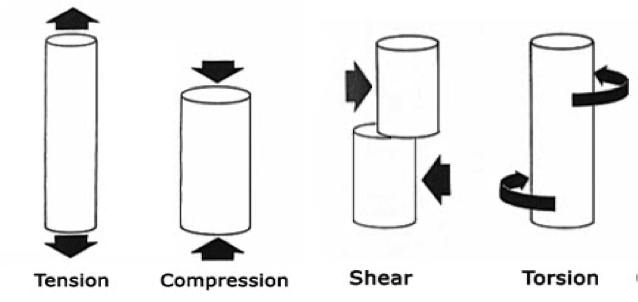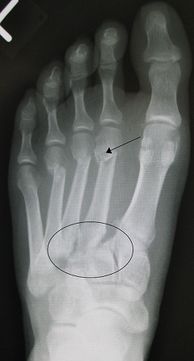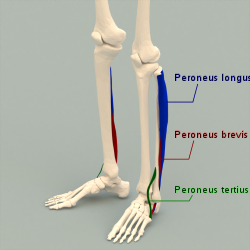Metatarsal Stress Fractures in the Athletic Population
Original Editors - Add your name/s here if you are the original editor/s of this page. User Name
Top Contributors - Heba Riyaz Abdulla, Rucha Gadgil, Vidya Acharya, Simisola Ajeyalemi, Kim Jackson, Emily Wiebenga and Maria Rshaidat
Definition/ Description[edit | edit source]
A metatarsal stress fracture is when a metatarsal bone of the foot experiences a crack or break due to biomechanical stresses applied to the tissue. This can take place in one of the metatarsals or multiple and can be at the head, shaft or base of the bone[1]. Theses fractures may happen to anyone however they are very common in athletes such as runners, basketball players, and ballet dancers, and soccer players. They are also more common on adolescents as their bones are still developing. The metatarsals bear most of the body’s weight while walking and running; consequently they make around 60% of adolescent fractures[2].
Biomechanically, there are different forces that could lead to these fractures; tension, compression, shear, and torsion.
Figure 1. Types of forces[3]
The most common way to fracture the metatarsal is when shear forces are acting on the bone. In comparison to the other types, metatarsals are most vulnerable to shear forces[4]. The fifth metatarsal is exposed and also more susceptible to these shear forces. This combination puts the fifth metatarsal at the highest likelihood of fracture – 59%[5].
Runners[edit | edit source]
While running, there are shear forces on the first and second metatarsals. The second metatarsal is more likely to get fractured due to high moments during running. The moment created by this bending can lead to a stress fracture over time. The probability of a stress fracture in the second metatarsal is also increased if it is longer than the first metatarsal. This is because the force increases significantly therefore creating a larger moment[6].
Basketball Players[edit | edit source]
Another common fracture is an avulsion fracture, which is caused by tensile forces. These forces can pull apart the axial end of the bone. The avulsion fracture is more often due to peroneus brevis tugging on the fifth metatarsal[4]. When the ankle is plantar flexed, an avulsion fracture can occur if the metatarsal is suddenly jerked into a different position, creating high tension in muscle and the plantar fascia.
Fractures like this are very often found in basketball players while running and jumping. When they experience repetitive tensile forces or sudden tensile forces, this could lead to a stress fracture[7].
Ballet Dancers[edit | edit source]
Repetitive compressive forces can also lead to stress fractures and these ones are oblique in nature. These are often seen in ballet dancers when they are en pointe. This is because they are in plantar flexion but it is a more extreme form of movement. There is strain caused by this on the ligaments and bones of the foot, especially around the Lisfranc – tarsometatarsal – joints. When dancing en pointe, the centre of gravity gets shifted more anteriorly to the shaft of the metatarsals, which puts more compressive forces on the metatarsals. When these forces are sudden or they are repetitive – where the muscles and bones are not strong enough yet – this could lead up to a stress fracture[8].
Figure 2. Lis Franc Fracture to the second and fourth metatarsal[9]
Soccer Players[edit | edit source]
Torsion can also cause a stress fracture. It was found that the insertions of peroneus longus and peroneus tertius induce strain on the fifth metatarsal. Due to their position, there is torsion created on the metatarsal. When the metatarsal is exposed to these forces repetitively, it can become a stress fracture[10]. This particular fracture happens at the base of the fifth metatarsal and is known as a Jones’ fracture[11] and commonly found in basketball and soccer players.
Figure 3. Peroneus Muscles[12]
There are studies that show correlations with decreased muscular strength and increased chance of fracture[13]. If the muscles are strong and flexible, this gives the foot a lot more stability and when there is mobilisation, the muscles are able to stretch enough without tearing. A study with soccer players tested the correlation between toe-grip strength and injury. It was shown that those who had less strength for the toe grip were significantly more prone to stress fractures[14]. The metatarsals can only sustain a certain amount of load depending on the strength of the muscles surrounding them as well as the bones itself. If the muscles are stronger, they can withstand more force and therefore the metatarsals would be less susceptible to a stress fracture. These muscles include flexor hallucis longus, flexor hallucis brevis, flexor digitorum longus, flexor digitorum brevis, and the lumbricals[15].
Summary[edit | edit source]
Metatarsal stress fractures can occur over time or due to sudden force. Different forces lead to distinctive fractures. While these can happen to anyone, they are more likely to emerge in the athletic population as they experience more strain than people performing daily activities. These fractures have been found to transpire in people who have weaker muscles and consequently there is not enough support given to the metatarsals and they are more liable to stress fractures.
References
- ↑ 1. Metatarsal Fractures [Internet]. Physiopedia. 2020 [cited 18 April 2021]. Available from: https://www.physio-pedia.com/Metatarsal_Fractures
- ↑ 2. Metatarsal Fractures [Internet]. Physiopedia. 2021 [cited 20 April 2021]. Available from: https://www.physio-pedia.com/Metatarsal_Fractures
- ↑ 3. Wikiradiography. Fracture Types and Mechanisms of Injury [Internet]. 2020 [cited 18 April 2021]. Available from: http://www.wikiradiography.net/page/Fracture_Types_and_Mechanisms_of_Injury
- ↑ 4.0 4.1 4. Hatch R, Alsobrook J, Clugston J. Diagnosis and Management of Metatarsal Fractures [Internet]. Aafp.org. 2017 [cited 19 April 2021]. Available from: https://www.aafp.org/afp/2007/0915/p817.html
- ↑ 5. Contributors P. Metatarsal Fractures. [Internet]. 2020 [cited 19 April 2021];. Available from: https://www.physio-pedia.com/Metatarsal_Fractures
- ↑ 6. Mayer S, Joyner P, Almekinders L, Parekh S. Stress Fractures of the Foot and Ankle in Athletes. Sports Health: A Multidisciplinary Approach [Internet]. 2013 [cited 19 April 2021];6(6):481-491. Available from: https://www.ncbi.nlm.nih.gov/pmc/articles/PMC4212349/
- ↑ 7. Mayer S, Joyner P, Almekinders L, Parekh S. Stress Fractures of the Foot and Ankle in Athletes. Sports Health: A Multidisciplinary Approach [Internet]. 2013 [cited 19 April 2021];6(6):481-491. Available from: https://www.ncbi.nlm.nih.gov/pmc/articles/PMC4212349/#:~:text=59-,Metatarsal,metatarsals%20and%20are%20relatively%20common.&text=They%20are%20considered%20high%20or%20low%20risk%2C%20depending%20on%20location.&text=Common%20in%20runners%2C%20military%20recruits,a%20recent%20increase%20in%20training
- ↑ 8. Albisetti W, Perugia D, De Bartolomeo O, Tagliabue L, Camerucci E, Calori G. Stress fractures of the base of the metatarsal bones in young trainee ballet dancers. International Orthopaedics [Internet]. 2009 [cited 19 April 2021];34(1):51-55. Available from: https://www.ncbi.nlm.nih.gov/pmc/articles/PMC2899256/
- ↑ 9. [Internet]. 2021 [cited 19 April 2021]. Available from: https://commons.wikimedia.org/wiki/File:Lisfranc_fracture.jpg
- ↑ 10. Vertullo C, Glisson R, Nunley J. Torsional Strains in the Proximal Fifth Metatarsal: Implications for Jones and Stress Fracture Management. Foot & Ankle International [Internet]. 2004 [cited 19 April 2021];25(9):650-656. Available from: https://pubmed.ncbi.nlm.nih.gov/15563388/
- ↑ 11. Bowes J, Buckley R. Fifth metatarsal fractures and current treatment. World Journal of Orthopedics [Internet]. 2016 [cited 19 April 2021];7(12):793. Available from: https://www.ncbi.nlm.nih.gov/pmc/articles/PMC5155254/
- ↑ 12. Peroneus muscles - Wikipedia [Internet]. En.wikipedia.org. 2021 [cited 19 April 2021]. Available from: https://en.wikipedia.org/wiki/Peroneus_muscles
- ↑ 13. Russell J. Preventing dance injuries: current perspectives. Open Access Journal of Sports Medicine [Internet]. 2013 [cited 19 April 2021];:199. Available from: https://www.ncbi.nlm.nih.gov/pmc/articles/PMC3871955/
- ↑ 14. Fujitaka K, Taniguchi A, Isomoto S, Kumai T, Otuki S, Okubo M et al. Pathogenesis of Fifth Metatarsal Fractures in College Soccer Players. Orthopaedic Journal of Sports Medicine [Internet]. 2015 [cited 19 April 2021];3(9):232596711560365. Available from: https://www.ncbi.nlm.nih.gov/pmc/articles/PMC3871955/
- ↑ 15. Soma M, Murata S, Kai Y, Nakae H, Satou Y. Strength and muscle activities during the toe-gripping action: comparison of ankle angle in the horizontal plane between the sitting upright and standing positions. Journal of Physical Therapy Science [Internet]. 2016 [cited 20 April 2021];28(3):992-995. Available from: https://www.ncbi.nlm.nih.gov/pmc/articles/PMC4842480/#:~:text=Toe%20gripping%20is%20defined%20as,%2C%20and%20flexor%20longus1).









